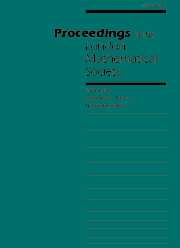Article contents
BIFURCATIONS OF PERIODIC POINTS OF HOLOMORPHIC MAPS FROM [Copf]2 INTO [Copf]2
Published online by Cambridge University Press: 01 September 1999
Abstract
Let $F: {\Bbb C}^n \to {\Bbb C}^n$ be a holomorphic map,$F^k$ be the $k$th iterate of $F$, and $p \in {\Bbb C}^n$be a periodic point of $F$ of period $k$. That is,$F^k(p) = p$, but for any positive integer $j$ with$j < k$, $F^j(p) \ne p$. If $p$ is hyperbolic, namelyif $DF^k(p)$ has no eigenvalue of modulus $1$, then it iswell known that the dynamical behaviour of $F$ is stablenear the periodic orbit $\Gamma = \{p, F(p),\ldots, F^{k-1}(p)\}$.But if $\Gamma$ is not hyperbolic, the dynamical behaviourof $F$ near $\Gamma$ may be very complicated and unstable.In this case, a very interesting bifurcational phenomenon mayoccur even though $\Gamma$ may be the only periodic orbit in someneighbourhood of $\Gamma$: for given $M \in {\Bbb N}\setminus \{1\}$,there may exist a $C^r$-arc $\{F_t: t\in [0,1]\}$(where $r \in {\Bbb N}$ or $r = \infty$)in the space ${\Bbb H}({\Bbb C}^n)$of holomorphic maps from ${\Bbb C}^n$ into ${\Bbb C}^n$,such that $F_0 =F$ and, for $t \in (0,1]$, $F_t$ has an$Mk$-periodic orbit $\Gamma_t$ with $d(\Gamma_t, \Gamma) =\sup_{p \in \Gamma_t}\inf_{q \in \Gamma} \|p - q\| \to 0$as $t \to 0$. The period thus increases by a factor$M$ under a $C^r$-small perturbation! If such an $F_t$ does exist,then $\Gamma$, as well as $p$, is said to be {\em $M$-tuplingbifurcational.} This definition is independent of~$r$.
For the above $F$, there may exist a $C^r$-arc $F^*_t$ in${\Bbb H}({\Bbb C}^n)$, with $t \in [0,1]$, such that$F^*_0 = F$ and, for $t \in (0,1]$, $F^*_t$ has two distinct$k$-periodic orbits $\Gamma_{t,1}$ and $\Gamma_{t,2}$ with$d(\Gamma_{t,i}, \Gamma) \to 0$ as $t \to 0$ for $i = 1,2$.If such an $F^*_t$ does exist, then $\Gamma$, as well as $p$,is said to be {\em $1$-tupling bifurcational.}
In recent decades, there have been many papers andremarkable results which deal withperiod doublingbifurcations of periodic orbits of parametrized maps.L. Block and D. Hart pointed out that period$M$-tuplingbifurcations cannot occur for $M > 2$ in the 1-dimensionalcase. There are examples showing that for any $M\in{\Bbb N}$, period $M$-tupling bifurcations can occurin higher-dimensional cases.
An $M$-tupling bifurcational periodic orbit as defined hereacts as a critical orbit which leads to period $M$-tuplingbifurcations in some parametrized maps. The main resultof this paper is the following.
{\sc Theorem.} {\em Let $k \in {\Bbb N}$ and $M \in {\Bbb N}$,and let $F: {\Bbb C}^2 \to {\Bbb C}^2$ be a holomorphic mapwith $k$-periodic point $p$. Then $p$ is $M$-tuplingbifurcational if and only if $DF^k(p)$ has a non-zeroperiodic point of period $M$.}
1991 Mathematics Subject Classification: 32H50, 58F14.
Information
- Type
- Research Article
- Information
- Proceedings of the London Mathematical Society , Volume 79 , Issue 2 , September 1999 , pp. 353 - 380
- Copyright
- 1999 London Mathematical Society
- 6
- Cited by

